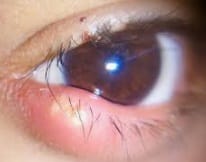The etymological origin of the term stye is found in Latin. Specifically, it should be noted that it derives from "hordeolus", which is the swelling of the eyelid and that, in turn, emanates from "hordeum", which can be translated as "barley". And a stye is considered to be the size of a grain of that cereal.
Likewise, it is interesting to know that it was the doctor Marcelo Empírico who, in the 4th century, proceeded to give shape to that aforementioned term that concerns us now. A term he created to name an inflammation that had already been detailed and described by Celsus in the 1st century.
This is the name given to a small boil that develops on the edge of an eyelid .
 It should be noted that a boil , also known as a boil , is an inflammation with pus that is generated when a hair follicle suffers an infection due to bacteria . This bacterial infection is responsible for the accumulation of pus in the tissue, causing the abscess .
It should be noted that a boil , also known as a boil , is an inflammation with pus that is generated when a hair follicle suffers an infection due to bacteria . This bacterial infection is responsible for the accumulation of pus in the tissue, causing the abscess .
Styes arise on the surface of the gland of Moll or the gland of Zeiss . Although it is not a serious disorder, it causes discomfort and pain and can even temporarily make vision difficult.
Other consequences that a stye can bring are suffering from constant tearing, having a lot of rheumy, suffering from a gritty sensation and even having hypersensitivity to light.
Staphylococcus aureus (scientific name Staphylococcus aureus ) is the bacteria that usually causes stye. The condition occurs when germs accumulate in the area and these microorganisms cause the abscess.
The inflammation of an external stye is soft to the touch and usually drains spontaneously. At the specific point of the injury, meanwhile, a nodule appears that can be quite painful. In the case of an internal stye , the abscess does not drain easily and therefore its healing takes longer.
Regarding the treatment of a stye , it is based on periodic hygiene of the area and the application of warm compresses . This helps the gland clear the blockage. It is important not to rub the area or squeeze the boil as this can aggravate the infection .
Likewise, it is recommended that the optimal measures to "fight" against the stye are using antibiotic-type ointments, stopping using makeup and even, to the extent possible, not wearing contact lenses.
In the same way, you should know that there are home tricks to deal with a stye. We are referring to the following:
-Clean the affected area with water and soap with neutral PH periodically.
-Place a hot tea bag on top of the stye.
-Resume using aloe vera in the eye area.
In addition, it is also considered good to apply anything from cucumber slices to gauze soaked in chamomile or acacia to the stye.
In some patients, the stye leaves a hard accumulation of fat in its aftermath. In this situation, its removal may be necessary through an incision with a scalpel or a surgical intervention, as considered by the doctor.
